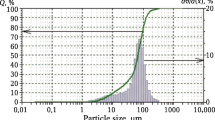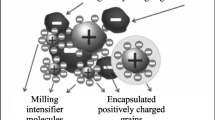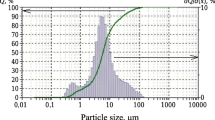Results of studying the process of fine milling of α-Al2O3 in the presence of polyethylene glycol (PEG) and an antistatic composition are presented. It is shown that the main reason for agglomeration of fine particles is the effect of appearance of an electrostatic surface charge. Introduction of PEG prevents appearance of a “pseudo-viscous milling medium”, removing the excess electrostatic charge at the surface of newly formed ultrafine particles, and also intensifies the wear process of primary alpha-alumina crystals. The antistatic composition successfully neutralizes a surface electrical charge, but does not exhibit a milling intensifier effect.








Similar content being viewed by others
References
N. D. Vorob’ev, “Modelling milling in ball mills,” Gorn. Zh., No. 5, 65 – 68 (2004).
M. A. Trubitsyn, N. A. Volovicheva, L. V. Furda, and V. G. Shukova, “Study of the effect of production parameters on grain size properties of submicron aluminium oxide in α-form,” Vestn. BGTU im V. G. Shukova., No. 12, 84 – 97 (2021).
M. A. Trubitsyn, N. A. Volovicheva, L. V. Furda, et al., “Research in the area of preparing activated alumina. Part 2. Efficiency of preparing finely dispersed aluminum oxide powder using a ball mill,” Refract. Ind. Ceram., 63(2), 137 – 142 (2022).
M. A. Trubitsyn, N. A. Volovicheva, L. V. Furda, et al., Study in the field of active aluminium oxide. Part 3. Efficiency of using Russian additive-intensifiers during milling high-alumina raw material,” Novye Ogneupory, No. 7, 33 – 41 (2022).
Yu. Guangbin, M. M. Kuznetsova, M. B. Makraovskii, and A. A. Aleksina, “Determination of hard material refinement process energy expenditure,” Zh. Tekhn. Fiz., 85(5), 145 – 147 (2015).
S. E. Andreev, V. A. Perov, and V. V. Zvrevich, Crushing, Refinement and Screening of Economic Minerals [in Russian], Nedra, Moscow (1980).
V. N. Glukharev, Dry Refinement Under Electroneutralization Conditions (in Russian), Izd. Politekhn. Univ., St. Petersburg (2014).
J. Tomas and S. Kleinschmidt, “Improvement of flowability of fine cohesive powders by flow additives,” Chem. Eng. Technol., 32(10), 1470 – 1483 (2009).
B. V. Deryagin, N. V. Churaev, and V. M. Muller, Surface Forces [in Russian], Nauka, Moscow (1985).
P. Prziwara, S. Breitung-Faes, snd A. Kwade, “Comparative study of the grinding aid effects for dry fine grinding of different materials,” Miner. Eng., 144, 106030 (2019). DOI: 10.1016/j. mineng.2019.106030.
H. Hasegawa, M. Kimata, and T. Shoji, “Effect of liquid additives and behavior of alumina powder in ultrafine grinding of alumina,” Journal of the Society of Powder, 39(10), 736 – 742 (2002). DOI: https://doi.org/10.4164/sptj.39.736.
P. Prziwara and A. Kwade, “Grinding aids for dry fine grinding processes. Part I. Mechanism of action and lab-scale grinding,” Powder Technology, No. 375, 146 – 160 (2020).. DOI: 10.1016/j. powtec.2020.07.038.
H. Dombrowe, B. Hoffmann, and W. Scheibe, “Über Wirkungsweise und Einsatzmöglichkeiten von Mahlhilfsmitteln,” Zement-Kalk-Gips., No. 11, 571 – 580 (1982).
H. Schubert, “Effects of fluid and additives on grinding processes,” Aufbereitungstechnik, No. 8, 115 – 120 (1988).
M. Shnabel’, A. Bur, D. Shmidtmaier, et al., “Contemporary ideas about melted and sintered refractory fillers,” Novye Ogneupory, No. 3, 107 – 114 (2016). DOI: https://doi.org/10.17073/1683-4518-2016-3.
S. Chatterjee, A. Buhr, et al., “Role of tabular alumina as a suitable aggregate for emerging applications — focus on dry ramming mix,” IREFCON, 97 – 103 (2014).
Author information
Authors and Affiliations
Corresponding author
Additional information
Translated from Novye Ogneupory, No. 5, pp. 100 – 107, May, 2023.
Parts 1 – 3 of the article published in Novye Ogneupory Nos. 3, 4, and 7 for 2022.
Rights and permissions
Springer Nature or its licensor (e.g. a society or other partner) holds exclusive rights to this article under a publishing agreement with the author(s) or other rightsholder(s); author self-archiving of the accepted manuscript version of this article is solely governed by the terms of such publishing agreement and applicable law.
About this article
Cite this article
Trubitsyn, M.A., Volovicheva, N.A., Furda, L.V. et al. Research in the Area of Preparing Activated Alumina. Part 5. Different Technological Approaches to the Process of Fine Milling of High-Alumina Raw Materials. Refract Ind Ceram 64, 284–290 (2023). https://doi.org/10.1007/s11148-024-00839-z
Received:
Published:
Issue Date:
DOI: https://doi.org/10.1007/s11148-024-00839-z




